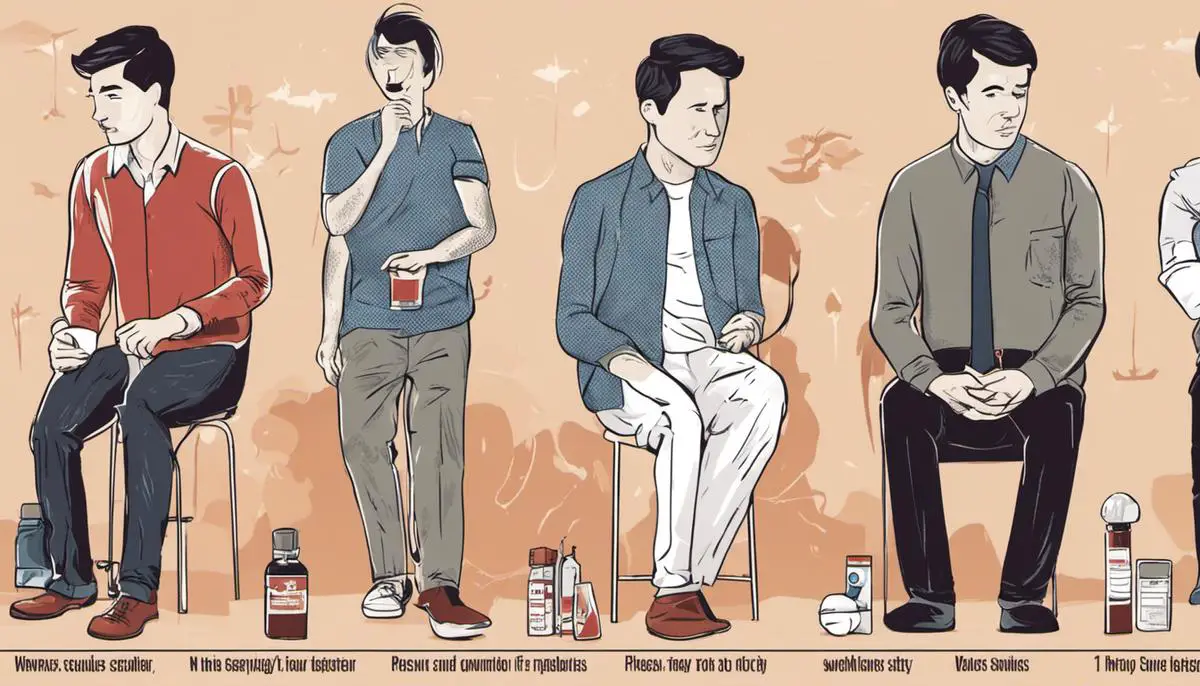Sexually transmitted diseases (STDs) represent an extremely important public health issue, affecting millions of people globally each year. Despite everyone being susceptible, unfair societal stigmas often discourage open discourse around them, resulting in widespread misinformation and misunderstanding. Leaving these stigmas and preconceptions behind, this detailed discourse aims to provide an intricate knowledge about STDs, focussing specifically on their implication in men. Our journey begins with a comprehensive understanding of STDs – their nature, types, and modes of spread – followed by a meticulous discussion on symptoms and complications in men to depict a vivid picture of the issue. Finally, we move towards the methodologies employed for diagnosis, treatment procedures available, and prevention measures to help empower men with information to be in control of their sexual health.
Understanding Sexually Transmitted Diseases (STDs)
What Are Sexually Transmitted Diseases?
Sexually transmitted diseases (STDs), also known as sexually transmitted infections (STIs), are infections that are passed from person to person through sexual contact. They can be caused by bacteria, viruses, or parasites. Some diseases, like HIV/AIDS, are life-threatening. Others, such as herpes and genital warts, can be uncomfortable and persistent, but are lesser threats to health.
How STDs Spread
STDs are primarily transferred through unprotected vaginal, anal, or oral sex with an infected partner, though some, like herpes and HPV, can be spread through skin-to-skin contact even without intercourse. Sharing needles for intravenous drug use can also transmit STDs, particularly HIV and hepatitis B and C. Men can contract STDs from both women and men, regardless of sexual orientation.
Types of STDs Common in Men
Several STDs are particularly prevalent in men. Here are a few examples:
- Gonorrhea and Chlamydia: These bacterial infections often occur together and can cause discomfort and discharge from the penis, though some men are asymptomatic.
- Syphilis: An infection that initially causes a painless sore on the genitals but can later lead to serious complications.
- Herpes (HSV): This virus creates periodic outbreaks of painful sores on the genitals. It remains in the body lifelong, though antiviral drugs can manage the symptoms.
- Human Papillomavirus (HPV): Some strains of HPV can cause genital warts, while others can lead to cancers including penile and anal cancer.
- HIV: This virus affects the immune system, making it difficult for the body to fight off infections and diseases, and can lead to AIDS.
Risk Factors
Several behaviors increase the risk of contracting an STD. The most significant is having unprotected sex. This includes vaginal, anal, or oral sex without a condom or other barrier method with someone who has an STD. The risk increases with the number of sexual partners. Drug and alcohol use can also lead to risky sexual behavior and increase the likelihood of contracting an STD.
Importantly, individuals can have an STD without showing symptoms, which can lead to unknowingly transmitting the infection to others. Therefore, regular STD testing is crucial, particularly if you have multiple sexual partners or have had unprotected sex.
Prevention and Treatment of STDs
In order to prevent Sexually Transmitted Diseases (STDs), employing safe sex practices is imperative. This includes consistent and correct use of condoms during sexual encounters, limiting the number of sexual partners, and being aware of their sexual health status. Some STDs, including HPV and hepatitis B, can be prevented through vaccination.
Treatments for STDs vary depending on the nature of the disease. Bacterial STDs like chlamydia and syphilis are usually curable with antibiotics. Viral infections such as HIV and herpes, on the other hand, have no cure, but their symptoms can be managed effectively with antiviral medications. Regular screenings for STDs play a vital role in early detection and successful treatment of these diseases, contributing to better health outcomes.
Overall, though sexual activity does come with certain risks, those risks can be significantly mitigated through preventive practices and maintaining an awareness of sexual health.

Symptoms and Complications of STDs in Men
Recognizing STD Symptoms in Men
The symptoms of sexually transmitted diseases (STDs) in men can differ widely in type and severity. Some common signs that may indicate an STD include discomfort while urinating, discharge from the penis that could be clear or colored, sores or blisters on or around the penis, and testicular pain. Other symptoms can include itching, swelling, or redness in the genital area.
Sometimes STDs like Chlamydia and Gonorrhea do not exhibit visible symptoms in men, although they can still inflict harm on the reproductive system. This highlights the importance of routine STD testing, especially for those who are sexually active, regardless of whether they are experiencing symptoms or not.
Chlamydia Symptoms in Men
Chlamydia, a bacterium transmitted during sexual contact, often displays no symptoms in men but when it does, symptoms generally appear one to three weeks after exposure. Men might experience a burning sensation when urinating, discharge from the penis, testicular pain, and rectal pain or discharge, especially in men having receptive anal intercourse.
Gonorrhea Symptoms and Complications
Like Chlamydia, gonorrhea symptoms, if they appear, will do so within two weeks of infection. These may include a yellow, white, or green urethral discharge, testicular or scrotal pain, and painful urination. If left untreated, gonorrhea can lead to complications like epididymitis, which is an inflammation of the tube at the rear of the testicle that carries sperm.
Syphilis Detection and Stages
Syphilis, another bacterial infection, is characterized by stages. The first stage, usually occurring about two to three weeks after exposure, is marked by a painless sore or multiple sores known as chancres. If not treated, it progresses to the second stage characterized by a skin rash, swollen lymph glands, and fever. In the most severe cases, left untreated, syphilis can cause neurological problems, cardiovascular complications, and even blindness.
HIV and AIDS
Probably the most severe of the STDs is HIV, which can progress to Acquired Immunodeficiency Syndrome (AIDS). Symptoms of HIV infection can occur between 2 to 4 weeks after transmission and may include flu-like symptoms such as high temperature, sore throat, headache, and skin rash. If not treated, HIV can severely impair the immune system, leading to AIDS, which can be fatal.
Herpes Symptoms in Men
Herpes, caused by two different but similar viruses (HSV-1 and HSV-2), can lead to painful blisters and ulcers in the genital area. Men may experience symptoms like fever, body aches, and swollen lymph nodes.
HPV in Men
Human papillomavirus (HPV) has more than 40 types that can infect the genital areas of men, including the skin of the penis, anus, and the lining of the mouth and throat. It may show no symptoms yet can lead to genital warts or various cancers.
Conclusion
Sexually active men, regardless of whether they depict visible symptoms or not, are strongly encouraged to undertake regular testing for Sexually Transmitted Diseases (STDs). Many of these diseases are effortlessly treatable if detected in their early stages. Ignorance or delayed treatment of these infections can lead to serious health repercussions. The most reliable preventive measures against STDs include practicing safe sex methods and maintaining monogamy.

Diagnosis, Treatment, and Prevention of STDs in Men
Identifying STDs in Men
The process of diagnosing STDs in men generally begins with a comprehensive dialogue about the symptoms, sexual history, and risk factors between the patient and the health practitioner. Physical examinations focusing on the genitals are pivotal, potentially expanding to oral and anal examinations contingent on individual sexual practices. Certain visually discernible symptoms like blisters or sores can point to herpes, and the appearance of genital warts may suggest HPV.
Through laboratory tests, we can identify STDs with a higher degree of accuracy. Urine tests can recognize many STDs, while for infections such as HIV, HPV, or syphilis, blood tests might be requisite. STDs such as gonorrhea and chlamydia can be spotted with a swab sample from the penis. In contrast, diseases like HPV could necessitate a biopsy.
Treatment of STDs in Men
Treatment for STDs depends on the specific disease. Some STDs caused by bacteria, such as chlamydia, gonorrhea, and syphilis, can be treated and fully eradicated with antibiotics. STDs caused by viruses, on the other hand, such as herpes, HPV, and HIV, do not have a cure but medications can help manage the symptoms and reduce the likelihood of transmission.
Antivirals are usually prescribed for herpes and HIV. For herpes, these can help control outbreaks, while for HIV, antiretroviral therapy can help people with the virus live a healthy, normal life. For HPV, treatment centers more around managing symptoms, such as removing genital warts, if they are present.
Prevention of STDs in Men
Prevention is a crucial part of managing STDs. Condom use during any sexual activity is one of the most effective ways to prevent the transmission of STDs. Regular screening for STDs is also important, even in the absence of symptoms, as many STDs can be asymptomatic.
Vaccines are available for certain STDs like HPV and Hepatitis B, and it is recommended that men get these vaccinations as per the guidelines. Another preventive approach for high-risk individuals involving HIV is pre-exposure prophylaxis (PrEP), where a person takes a daily pill to significantly reduce their chances of getting infected.
Communication and STDs
Open communication with all sexual partners about sexual health and history is fundamental. This openness aids prevention and early diagnosis, reducing the spread of STDs. It might not always be an easy conversation to have, but it’s a vital one. Discussing past STD tests and agreeing to get tested together serves not just individual health but also public health.
Ultimately, the responsibility for sexual health rests with the individual.
Regular check-ups, safe sex practices, vaccination, and candid discussion with partners are all key steps to diagnose, treat, and prevent STDs in men.

Protecting yourself from STDs involves more than just utilizing contraceptives – it involves becoming educated, getting tested regularly, and engaging in open conversations with your partners about sexual health. By understanding what STDs are, how they spread, the symptoms they manifest, and the complications that can potentially arise – one can make informed decisions for themselves and their sexual partners. Armed with the right information, regular check-ups, proper medication, and vaccination when required, we can all lead safe, healthy sexual lives. The last word on this topic – remember that STDs are a part of our world and there’s no shame in discussing and dealing with them. Let education and awareness prevail over stigma and fear.
